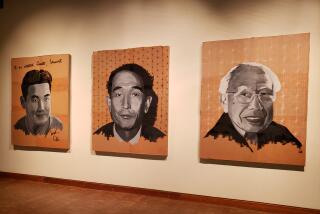Happy 80th birthday, Yoko Ono
- Share via
Yoko Ono gets a bad rap. She’s the one who broke up the Beatles, who pushed John Lennon into baking bread. Except, of course, it’s much more complicated than that.
Ono was already an established avant-gardist when she met Lennon, famously, at London’s Indica Gallery in 1966; inspired by John Cage, she worked with the Fluxus group in New York in the early 1960s and collaborated with experimental composer La Monte Young.
Among her work from this period is “Cut Piece,” a participatory bit of performance art in which Ono came on stage in a loose shift and encouraged audience members to cut the garment off her piece by piece.
Ono turns 80 on Monday, and to mark the occasion, I’ve been looking at another of her early projects, the book “Grapefruit,” published in 1964. Somewhere between Zen poetry and a series of instructions for living, “Grapefruit” is literature as conceptual art, a sheaf of “event scores” that suggest how to turn daily life into something more engaged.
Perhaps the best-known effort in the collection is “Cloud Piece,” originally composed in 1963, which reads, in its entirety:
Imagine the clouds dripping.
Dig a hole in your garden to
put them in.
It appeared on the back cover of Lennon’s 1971 album “Imagine,” and is said to have inspired the title track.
I’ve loved “Grapefruit” from the moment I laid eyes on it, loved its sense of whimsy, its sense of play. The instructions range from the inspirational (“A dream you dream alone may be a dream, but a dream two people dream together is a reality”) to the prosaic (“Step in all the puddles in the city”) to the surreal.
In “Mirror Piece,” written in the spring of 1964, Ono urges:
Instead of obtaining a mirror,
obtain a person.
Look into him.
Use different people.
Old, young, fat, small, etc.
The work here reads like haiku, or even tweets. (There’s a reason Ono is currently a Twitter star.)
What all this has to offer is a way of thinking, of being conscious in the world. The universe is a place of wonder, Ono means to tell us, but we must remind ourselves to look. This is the key to creativity, to being present, which “Grapefruit” insists, begins with every one of us.
Or, as she writes in “Painting for the Wind”:
Cut a hole in a bag filled with seeds
of any kind and place the bag where
there is wind.
ALSO:
Maged Zaher’s out-to-lunch poem
Yannis Ritsos and the poetry of witness
Remembering John Lennon through his letters (and postcards)
More to Read
Sign up for our Book Club newsletter
Get the latest news, events and more from the Los Angeles Times Book Club, and help us get L.A. reading and talking.
You may occasionally receive promotional content from the Los Angeles Times.











